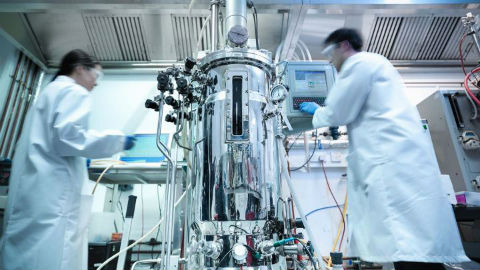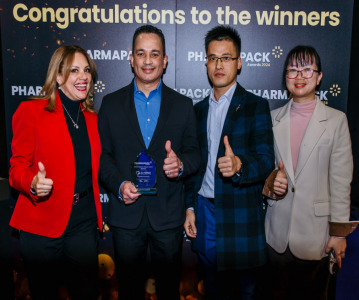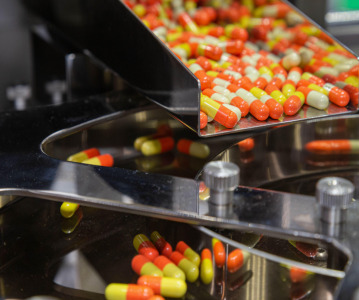Bioconjugation expertise and increased productivity in bio over next 5 years

Smaller bioreactors and high-density perfusion techniques needed as manufacturing makes significant efficiency improvements.
Ahead of the inaugural edition of bioLIVE – the bioprocessing and manufacturing event opening October (9-11) in Madrid – CPHI Worldwide announces the bio findings of its annual report, which foresees much greater efficiency in biomanufacturing and an increased exchange of ideas across small and large molecule industries.
CPHI Annual report expert, Mike Ultee of Ulteemit BioConsulting projects great strides being made in improving bioprocessing techniques and, in particular, cell line productivity for recombinant proteins. He predicts that over the next 5 years productivity of fusion proteins and enzymes will move towards the 2-5 g/L range. The consequence of which is that we are likely to see continued moves towards smaller bioreactors.
Ultee also argues that the rise in the use of continuous bioprocessing will see the return of perfusion bioreactors aided by inline new filtration technologies – ultrafiltration, diafiltration and concentration equipment. In fact, high-efficiency perfusion techniques will also enable extremely high densities (~ 108 cells/mL) in small volumes. Most excitingly, the pipeline of CAR-T and gene therapies will now come to market in increasing numbers as bioprocessing techniques have proved reliable in bringing products through clinical and commercial production.
“In 5 years' time we will have been through a golden period, with game-changing improvements made in upstream, downstream and continuous bioprocessing. The market will by then also boast much greater numbers of biosimilars and new applications for cell and gene therapies. The industry is collectively maturing extremely quickly from Big Pharma and biosimilars to CDMOs,” added Ultee.
Kent Payne, CEO of Socorro Pharmaceuticals LLC explores in his analysis how demand is now outstripping supply for qualified bio professionals in the big bio hubs – notably Boston and San Francisco – and increasingly we will see small molecule professionals moving across, especially in areas like conjugation and ADCs where there is directly transferable expertise.
However, his conclusion was that as biomanufacturing enters its maturation stage, especially amongst the smaller nimble biotechs, they will increasingly look borrow from practices already established in the small molecule segment rather than by ‘any means to market’.
“There are lessons to be learned from Pharma peers to drive enhanced productivity and quality, whilst simultaneously lowering costs. The processes and skills that have been honed at larger companies to drive operational excellence are key to the smaller companies’ growth and profitability prospects. As small companies reach a tipping point in their life cycle, they must move beyond the ‘just get it done by any means’ mode to a ‘growth by design’ mode in order to be prepared for commercialization and beyond,” commented Payne.
In particular, it is in the supply chain and management systems where there are likely to be great efficiencies yet to be discovered. Payne concluded: “over the last decade or so, many of the larger biomanufacturing players have implemented more sophisticated production management systems to provide real monitoring and optimization. Nevertheless, compared with small molecule counterparts, there is still much room for improvement.”
Rutger Oudejans, Brand Director at UBM for bioLIVE said: “The findings in our Annual Report clearly support the need for introducing an event like bioLIVE – one that supports the benefits of the growing exchange of ideas across small molecule and biomanufacturing. What is most exciting is that in an age of renewed innovation and with drug attrition rates falling that we might also be able to bring these new biologics to market much cheaper. It’s one of the central themes of this year’s inaugural event, ‘how to help transition the growing workforce needed in bio’ and, of course, ‘how we can make manufacturing more efficient and bring medicine to patients faster’. The synergies we are seeing with small and large molecule in the long-term will help both industries innovate and commercialize better in the future.”
Related News
-
News Pharmapack Awards 2024 Patient-Centric Design Award Winner – Dr Ferrer BioPharma
The 2024 Pharmapack Awards celebrated the best in innovation and design for the pharmaceutical packaging and drug delivery industry on January 24, 2024. -
News Women in Pharma: Minding the Gap at Pharmapack 2024
2024 marks the first year Pharmapack will host a Diversity track dedicated to bridging the gap within the pharmaceutical packaging and drug delivery sector. The track includes a panel discussion on 'Enabling Diversity in the Workplace,' focused... -
News Pharmapack Awards 2024 - Celebrating Packaging and Drug Delivery Innovation
The 2024 Pharmapack Innovation Awards ceremony celebrated the best in pharmaceutical packaging and drug delivery innovation at all levels. The awards were held on January 24, 2024 at the Paris Expo Porte de Versailles. -
News 2024 Pharma Industry Trends Outlook: Collaboration, Market Maturity, and Digital Futures
The annual CPHI Online 2024 Pharma Trends Outlook, in partnership with Arvato Systems, identifies 12 key industry trends shaping the life sciences industry in the coming year. -
News New Novo Nordisk AI hub for drug discovery to open in London, UK
Danish pharmaceutical giant Novo Nordisk will be opening an AI-based research facility in the heart of London to advance drug discovery operations. -
News BioNTech to begin mRNA vaccine manufacturing in Rwanda by 2025
German biotechnology company BioNTech has stated their intentions to begin production at their mRNA vaccine factory in Rwanda by 2025, which will mark the first foreign mRNA vaccine manufacturing site on the continent of Africa. -
News Women in Pharma: Looking back on 2023 and moving forward to 2024
In this monthly series, we interview women from across the pharmaceutical industry and supply chain to discuss the importance of gender diversity in healthcare, the workplace, and beyond. -
News CPHI Barcelona 2023: Partnering for Success – Managing Outsourcing Relationships to Optimise Manufacturing Operations
During CPHI Barcelona 2023, insightful content sessions offered attendees the chance to explore trending topics with expert speakers and panellists. Here, we summarise what the pharma industry and supply chain are talking about the most.
Position your company at the heart of the global Pharma industry with a CPHI Online membership
-
Your products and solutions visible to thousands of visitors within the largest Pharma marketplace
-
Generate high-quality, engaged leads for your business, all year round
-
Promote your business as the industry’s thought-leader by hosting your reports, brochures and videos within your profile
-
Your company’s profile boosted at all participating CPHI events
-
An easy-to-use platform with a detailed dashboard showing your leads and performance







